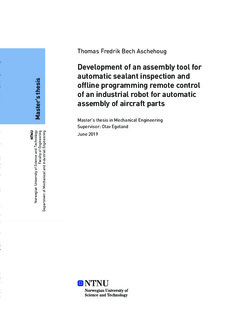| dc.contributor.advisor | Egeland, Olav | |
| dc.contributor.author | Aschehoug, Thomas | |
| dc.date.accessioned | 2019-10-19T14:00:42Z | |
| dc.date.available | 2019-10-19T14:00:42Z | |
| dc.date.issued | 2019 | |
| dc.identifier.uri | http://hdl.handle.net/11250/2623316 | |
| dc.description.abstract | Den fjerde industrielle revolusjonen, Industri 4.0, dreier seg om den tekniske utviklingen av industriell automasjon. Målet med Industry 4.0 er å øke produktiviteten og effektiviteten i maskiner og produksjonsanlegg. Denne oppgaven undersøker hvordan man kan nærme seg dette målet gjennom å utvikle et tilpasset monteringsverktøy og ved å bruke offline programmering for fjernkontroll av en industrirobot for automatisk montering av tre aluminiumsdeler.
Det utviklede monteringsverktøyet ble brukt til de to delprosessene for å plukke og plassere aluminiumsdelene og påføre tetningsmasse. Prosessen ble utført automatisk av en UR10 industrirobot. For å håndtere plukking- og plasseringsprosessen, ble det brukt en pneumatisk vakuumgriper. For påføringen av tetningsmasse ble det utviklet et tilpasset tetningsmiddelverktøy, som brukte lineæraktuatorer til å skyve stempelhodet på en fugepistol. Aktuatorene ble styrt automatisk av robotkontrolleren til UR10 roboten. Både de mekaniske og mekatroniske aspektene ved tetningsmiddelverktøyet er deler av oppgavens omfang. For at UR10 skulle kunne utføre begge oppgavene automatisk, ble det utviklet en monteringsmekanisme for å bære både vakuum- og tetningsmiddelverktøyet samtidig. Til slutt evalueres den samlede ytelsen til monteringsverktøyet.
Tetningsmiddelverktøyet ble brukt til automatisk påføring av tettningsmiddel. Målet med testene var å finne ut hvordan man skulle justere tetningsmiddelverktøyet riktig til å påføre den korrekte mengden tetningsmasse og å vurdere verktøyets pålitelighet.
Den andre delen av oppgaven dreier seg om bruk av offline programmering for fjernkontroll av UR10. Programvaren Visual Components ble koblet til UR10 via en sanntids datautvekslingsforbindelse. Tilkoblingen utnyttet inngangsregistre og en synkroniseringsløkke for datautveksling i santid for å sende leddvariabler fra simuleringen i Visual Components til UR10. Resultatet var at UR10 kunne fjernstyres og programmeres til å utføre monteringsprosessen uten behov for programmeringsferdigheter. | |
| dc.description.abstract | The fourth industrial revolution, Industry 4.0, revolves around the technical advancements of industrial automation. The goal of Industry 4.0 is to increase productivity and efficiency in machinery and manufacturing facilities. This thesis explores how to approach this goal by developing an assembly tool and by using offline programming for remote control of an industrial robot to automatically assemble three aluminium aircraft parts.
The developed assembly tool was used for the two subprocesses of picking and placing the aluminium parts and applying sealant. The process was performed automatically by a UR10 industrial robot. To handle the pick and place subprocess of the assembly, a pneumatic vacuum gripper was used. For the sealant application a custom sealant tool was developed, which used linear actuators to push the plunger head of a caulking gun. The actuators were automatically controlled by the robot controller of the UR10. Both the mechanical and mechatronical aspects of the sealant tool are described in the scope of this thesis. For the UR10 to perform both tasks automatically, a mounting mechanism for wielding the vacuum and sealant tools simultaneously was developed. Finally, the overall performance of the assembly tool is evaluated.
The sealant tool part of the assembly tool was used for automatic sealant application testing. The goals of the tests were to figure out how to tune the sealant tool properly to apply the correct amount of sealant and to assess the reliability of the tool.
The second part of the thesis, revolves around the use of offline programming to remote control the UR10. The offline programming software Visual Components was connected to the UR10 through a Real-Time Data Exchange socket connection. The connection exploited general purpose input registers and a Real-Time Data Exchange Synchronization Loop to send joint variables from the simulation in Visual Components to the UR10. The result was that the UR10 could be remote controlled and programmed to perform the assembly process, without the need for programming skills. | |
| dc.language | eng | |
| dc.publisher | NTNU | |
| dc.title | Development of an assembly tool for automatic sealant inspection and offline programming remote control of an industrial robot for automatic assembly of aircraft parts | |
| dc.type | Master thesis | |
